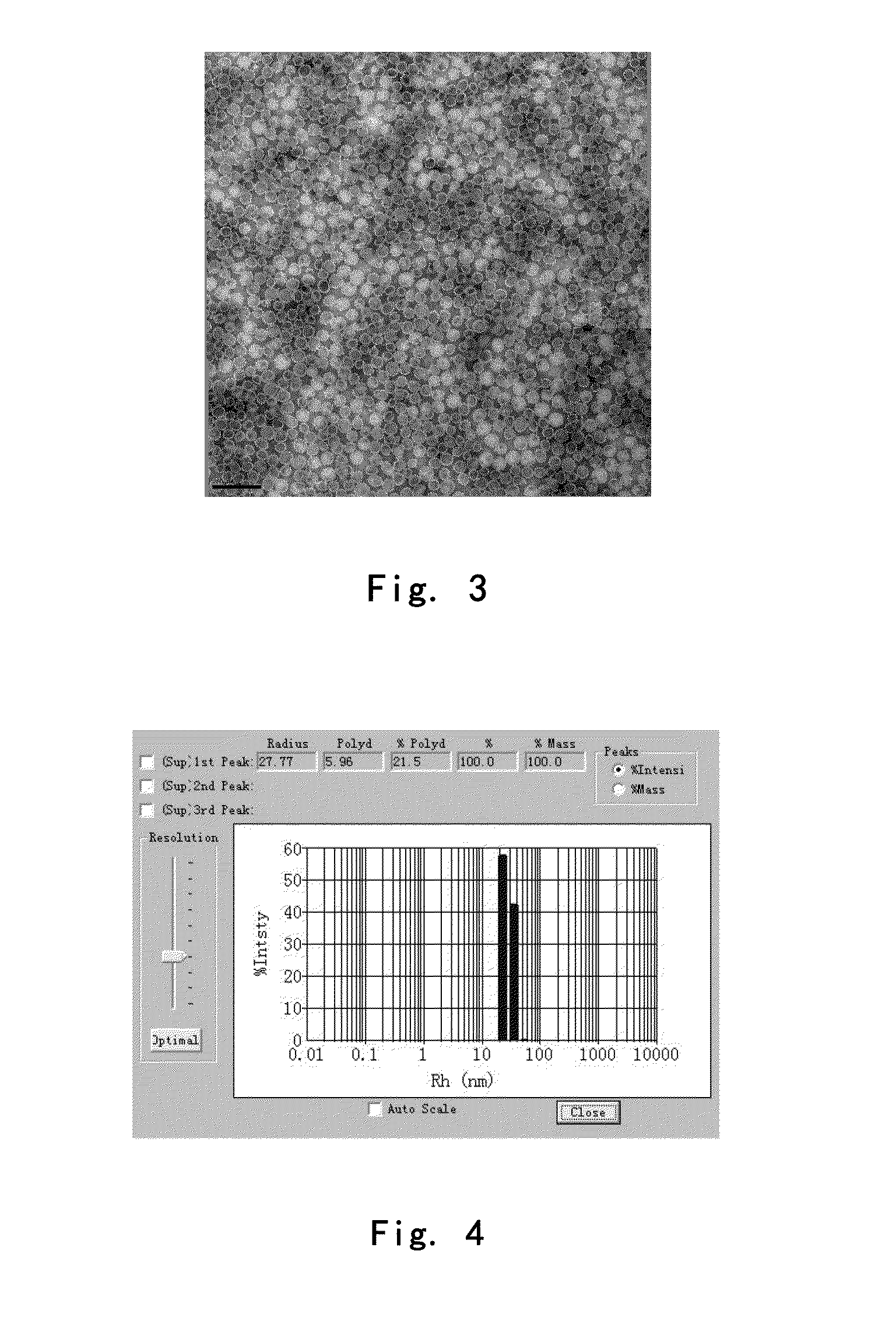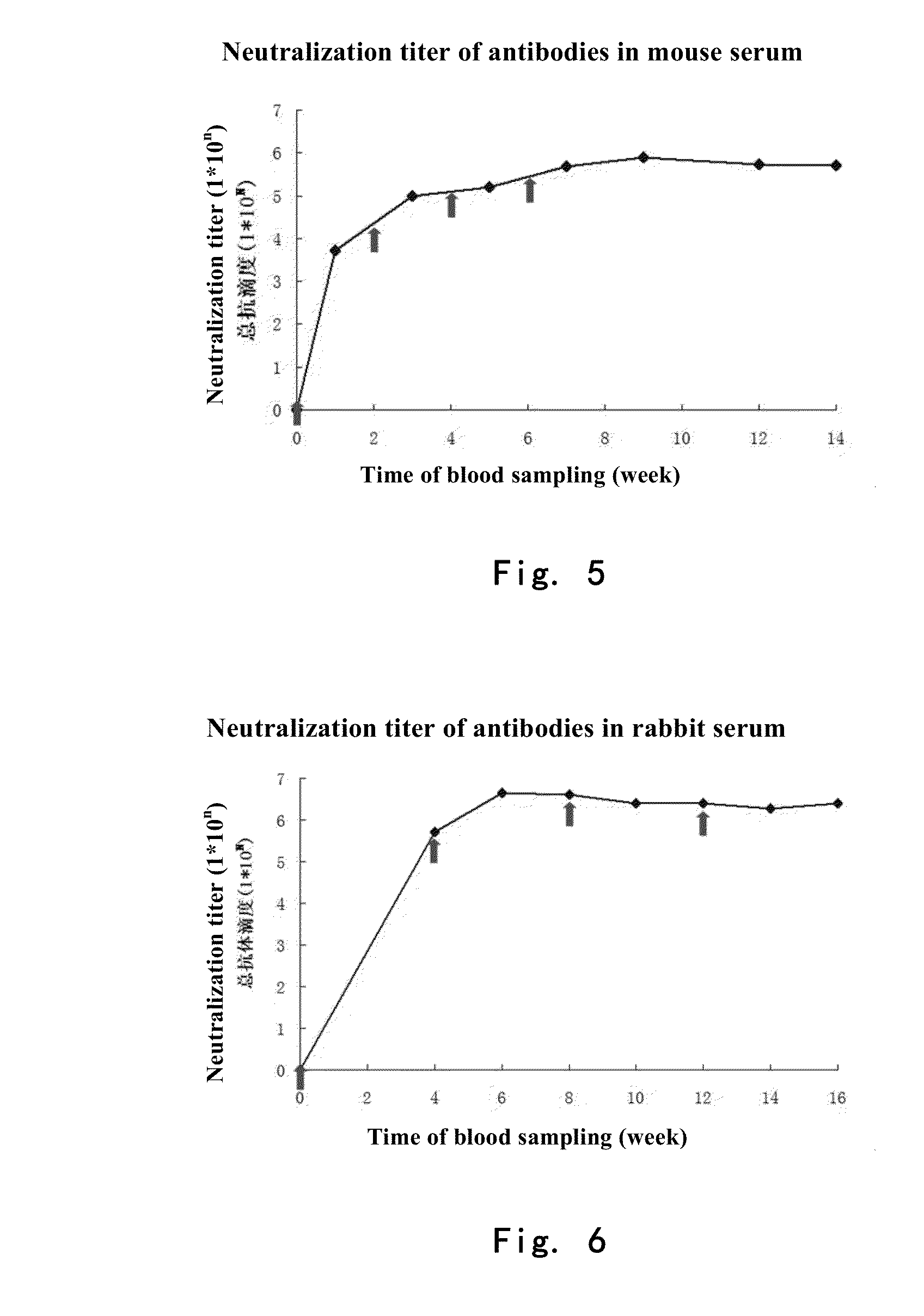Truncated l1 protein of human papillomavirus type 33
- Summary
- Abstract
- Description
- Claims
- Application Information
AI Technical Summary
Benefits of technology
Problems solved by technology
Method used
Image
Examples
example 1
Expression of the Truncated HPV33 L1 Protein Set Forth in SEQ ID NO
[0084]Preparation of HPV33 L1 Full-Length Gene Fragment
[0085]The DNA, extracted from the vaginal secretion of patients with cervical cancer from Xiamen City, Fujian Province, was used as template. The forward primer was HPV33S: 5′-CAT ATG TCC GTG TGG CGG CCT AG-3′ (SEQ ID NO:12), and the reverse primer was HPV33 R: 5′-GTC GAC TTA TTT TTT AAC CTT TTT GC-3′ (SEQ ID NO:13). The PCR reaction was performed in a PCR thermocycler (Biometra T3) to prepare HPV33 L1 full-length gene fragment under the following conditions:
94° C. denaturation 10 min 1 cycle94° C. denaturation 50 sec25 cycles56° C. annealing 50 sec72° C. elongation 1.5 min72° C. elongation 10 min 1 cycle
[0086]In HPV33-positive samples, the products of about 1.5 kb in length were obtained after amplification. After sequencing, three HPV33 L1 gene sequences (SEQ ID NOs: 1, 2 and 3) were obtained. In the present Example, SEQ ID NO: 1 was used as template for prepar...
example 2
Preparation of HPV33N9C-L1 Protein with a Purity of about 70%
[0106]Bacteria were re-suspended at a proportion of 1 g bacteria to 10 ml lysis buffer (20 mM Tris buffer pH 7.2, 300 mM NaCl). Bacteria were disrupted by an APV homogenizer (Invensys Group) for five times at a pressure of 600 bar. The homogenate was centrifuged at 13,500 rpm (30,000 g) for 15 min, and the supernatant (i.e. the supernatant of disrupted bacteria) was obtained. The supernatant was subjected to 10% SDS-PAGE. At this stage, the HPV33N9C-L1 protein in the supernatant had a purity of about 10% (see FIG. 1, Lane 1).
[0107]The supernatant was dialyzed by a CENTRASETTE 5 Tangential Flow Filter (Pall Co.) running at a pressure of 0.5 psi, a flow rate of 500 ml / min, and a tangential flow rate of 200 mL / min, wherein the membrane retention molecular weight was 30 kDa, the dialysis solution was 10 mM phosphate buffer pH 6.0, and the dialysis volume was three times of the volume of the supernatant.
[0108]After thorough dia...
example 3
Chromatographic Purification of HPV33N9C-L1 Protein
[0109]Purification of HPV33N9C-L1 by Cation Exchange Chromatography
[0110]Equipment: AKTA Explorer 100 preparative liquid chromatography system produced by GE Healthcare (i.e. the original Amershan Pharmacia Co.)
[0111]Chromatographic media: SP Sepharose 4 Fast Flow (GE Healthcare Co.)
[0112]Column Volume: 5.5 cm×20 cm
[0113]Buffer: 20 mM phosphate buffer pH 8.0, 20 mM DTT[0114]20 mM phosphate buffer pH 8.0, 20 mM DTT, 2M NaCl
[0115]Flow Rate: 25 mL / min
[0116]Detector Wavelength: 280 nm
[0117]Sample: about 70% pure HPV33N9C-L1 protein solution, as filtered through a filter membrane with an aperture of 0.22 μm in Example 2.
[0118]Elution protocol: eluting undesired proteins with 400 mM NaCl, eluting the protein of interest with 800 mM NaCl, collecting eluate eluted with 800 mM NaCl.
[0119]Purification of HPV33N9C-L1 by CHT-II Chromatography (Hydroxyapatite Chromatography)
[0120]Equipment: AKTA Explorer 100 preparative liquid chromatography sys...
PUM
| Property | Measurement | Unit |
|---|---|---|
| Molar density | aaaaa | aaaaa |
| Molar density | aaaaa | aaaaa |
| Molar density | aaaaa | aaaaa |
Abstract
Description
Claims
Application Information
 Login to View More
Login to View More - R&D
- Intellectual Property
- Life Sciences
- Materials
- Tech Scout
- Unparalleled Data Quality
- Higher Quality Content
- 60% Fewer Hallucinations
Browse by: Latest US Patents, China's latest patents, Technical Efficacy Thesaurus, Application Domain, Technology Topic, Popular Technical Reports.
© 2025 PatSnap. All rights reserved.Legal|Privacy policy|Modern Slavery Act Transparency Statement|Sitemap|About US| Contact US: help@patsnap.com



